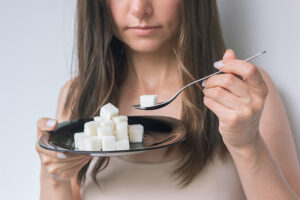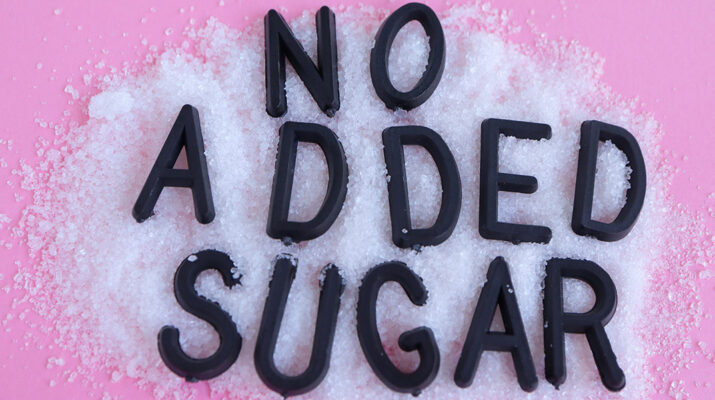You’re probably eating more sugar than you’re aware
By Deborah Jeanne Sergeant

American adults eat about 17 teaspoons of added sugar daily, more than two times the recommended daily allowance, according to the American Heart Association. Over a year, that is about 60 lbs. of added sugar.
How?
Of course, foods like candy, treats and soda are obvious sources of added sugar. But “hidden” sugar sometimes lurks where you would not anticipate.
“Being aware of these hidden sugars, particularly added sugars, is important, especially if you’re trying to limit or control your sugar intake due to health concerns like diabetes or for goals such as weight management,” said Imalai “Mali” Rosado, lifestyle health coach and diabetes prevention educator at Well-U Employee Wellness/Lifestyle Management at University of Rochester’s Center for Community Health & Prevention.
“Even savory foods may contribute significantly to daily added sugar intake. For example, one can of Campbell’s tomato soup contains 20 grams of added sugar,” Rosado added. “Monitoring your added sugar consumption helps support better overall health, energy levels, and long-term wellbeing.”
The “daily allowance” isn’t a requirement. Ideally, a diet should have no added sugar. Some foods contain naturally occurring sugar; however, look for “added sugar” on the label.
Added sugar “is what we need to be concerned about,” said Molly Ranney, registered dietitian and certified specialist in obesity and weight management at Highland Hospital. “Sugar derived from eating a piece of fruit is less concerning.”
When buying canned fruit, look for fruit packed in water or fruit juice, not syrup which is made of sugar. Unsweetened applesauce is also a better choice. Add plain ground cinnamon (not cinnamon and sugar) to enhance its flavor. Buy dried fruit from the baking aisle, where it’s usually sold without a dusting of sugar, unlike the snack aisle.
Look for 100% fruit juice, not juice cocktail or juice drinks. Some labels are tricky as they boast 100% vitamin C — not 100% juice — and are brimming with sugar.
Examine beverages like fancy coffee drinks, boba tea and smoothies. Unless you make them yourself at home, most of these are liquid desserts. Learn how to create your own and to order flavorful drinks without so much sugar.
Breakfast cereal can provide a convenient, whole grain breakfast option, but look for no- and low-sugar options. Nearly all “children’s” cereals are loaded with sugar.
Many people look at foods such as yogurt as wearing healthfulness halos; however, nearly all of these are chock full of sugar.
“Some of the yogurts if you look at them have as much sugar as a cookie,” Ranney said. “That’s the concerning piece. As a consumer, it can get very confusing. You see yogurt and think it’s super healthy and it has 20 grams of sugar.”
Try plain yogurt with a little pure vanilla extract and berries for added flavor and sweetness.
Most protein bars, granola bars, fruit snacks, sweetened dried fruit and fruit and cereal bars have as much sugar as dessert as well. Check the labels for low-sugar varieties.
“When you read an ingredient list, if sugar is first, second or third on the list, it’s a no-brainer.” Ranney said.
Energy drinks and sports drinks seem like an easy way to get a boost during the day, but many kinds serve up plenty of excess sugar. Choose a zero-sugar variety or hydrate with sparkling water, flavored ice water (just a few lemon wedges to a pitcher) or plain old water.
“Young kids are getting the message that soda is bad for you but aren’t switching to something much better,” Ranney said.
Although condiments don’t comprise a large part of most people’s diets, many things like ketchup and barbecue sauce contain a lot of sugar. Since it all adds up, switching to low-sugar varieties can help reduce intake.
Jennifer Haberbusch Director of Clinical Nutrition Rochester Regional Health, noted that prepared foods like frozen meals and pasta sauce often contain high levels of sugar, although they may be listed as something else (see sidebar).
“I believe you can incorporate anything in a diet, but choose more often foods that aren’t processed,” Haberbusch said. “You can’t completely avoid added sugars nor should you. They taste good. But they add additional calories into your diet and if you’re not burning it off, it can add up to extra weight gain.
“We struggle with weight issues in America and that comes with a host of its own issues like type 2 diabetes and heart disease and metabolic syndrome. All foods fit into a diet. There’s nothing wrong with eating canned fruit over fresh fruit. But make the most informed choices.”
Why Excess Sugar is Bad
Excess added sugar in the diet increases overall caloric intake quickly, as the calories are very concentrated. Foods high in added sugar often provide little nutritional benefit. They cause the blood sugar to spike and then crash, resulting in overeating later.
Top Sources of Sugar
According to the American Heart Association, these are the major sources of added sugar:
Sugar-sweetened beverages – 24 %
Desserts and sweet snacks – 19%
Soft drinks – 16%
Coffee/tea – 11%
Candy – 9%
Sandwiches – 7%
Breakfast cereals and bars – 7%
Cookies and brownies – 6%
Fruit drinks – 5%
Ice cream and frozen dairy
desserts – 5%
 Finding Sugar By a Different Name
Finding Sugar By a Different Name
Sugar goes by numerous other names in ingredient lists, including:
• Cane juice
• Cane juice crystals
• Cane sugar
• Cane syrup
• Caramel
• Carob syrup
• Corn glucose syrup
• Corn syrup
• Corn syrup solids
• Date syrup
• Dextrose
• Drimol
• Ethyl maltol
• Evaporated cane juice
• Flo malt
• Florida crystals
• Fructose
• Fruit juice concentrate
• Glucose
• Glucose solids
• Golden syrup
• Grape sugar
• High fructose corn syrup
• Isoglucose
• Isomaltulose
• Kona-ame
• Malt syrup
• Maltodextrin
• Maltose
• Molasses
• Nulomoline
• Refiner’s syrup
• Rice syrup
• Sorghum syrup
• Starch sweetener
• Sucanat
• Sucrovert
• Sugar beet
• Treacle or treacle sugar

